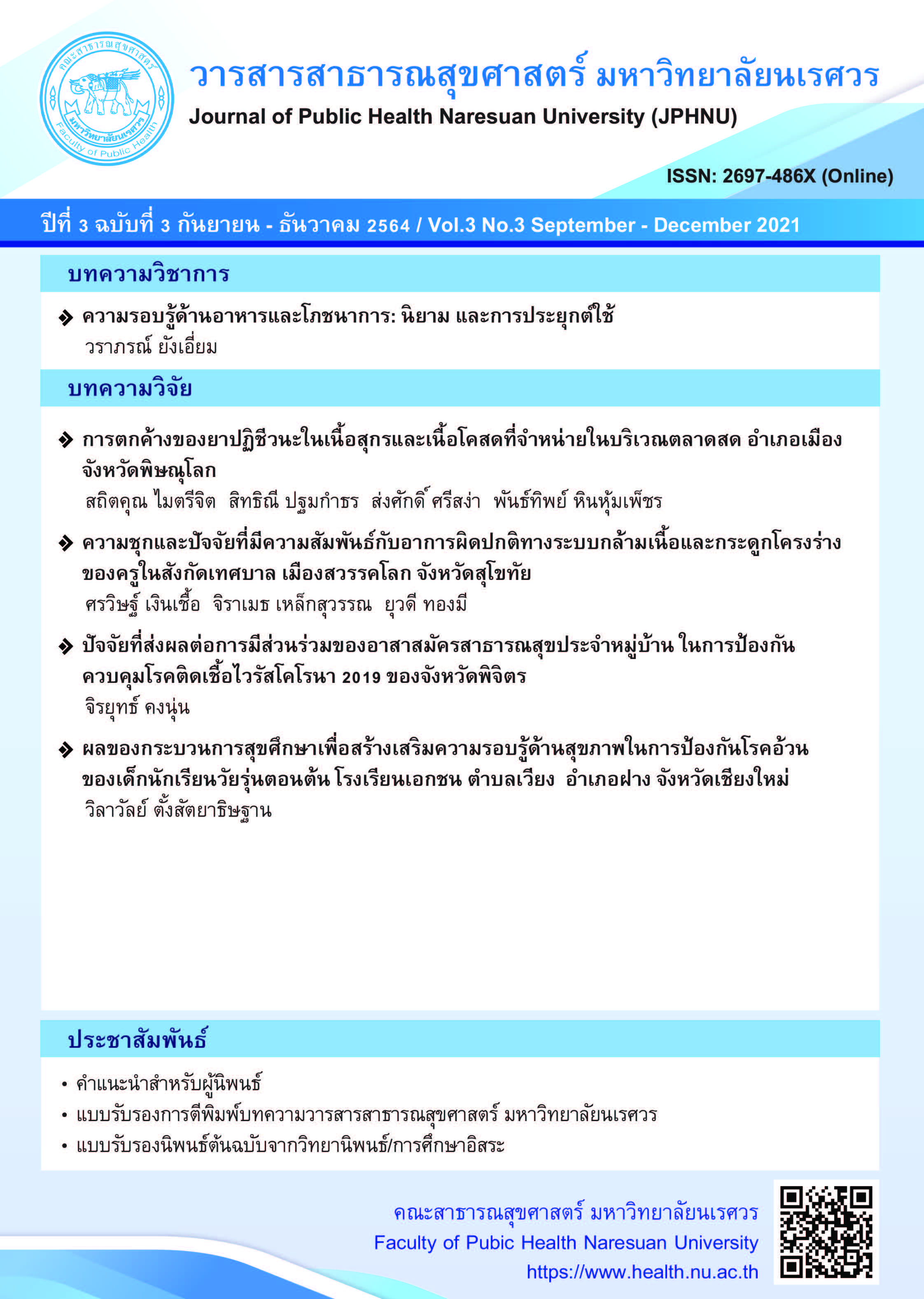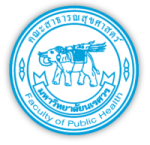Food and nutrition literacy: Definitions and applications
Keywords:
Nutrition literacy, Health literacy, Food literacyAbstract
Food literacy and nutrition literacy emerged from the concept of health literacy. Food and nutrition literacy is to promote cognitive skills and competency of people that emphasize food and nutrition. Principal outcomes were to increase food and nutrition knowledge, food skills, dietary consumption behavior, and improve the positive health outcomes.
This article conducted a literature review regarding food and nutrition literacy concepts from academic and research articles, which were accepted both at national and international levels from 2001 to 2022. The objective was to describe meanings, components, and the applications of food and nutrition literacy concepts in health promotion and non-communicable diseases prevention associated with dietary consumption behavior. This article benefits health sectors, schools, and related organizations, which applied these concepts to promote food and nutrition literacy, food skills, dietary consumption behavior; to promote healthy people and increase the quality of life.
References
Azevedo, P. E., Thomas, H., Samra, H. R., Edmonstone, S., Davidson, L., Faulkner, A. et al. (2017). Identifying attributes of food literacy: A scoping review. Public Health Nutrition, 20(13), 2406-2415.
Bedoyan, J., McNamara, J., Olfert, M., Byrd- Bredbenner, C., & Greene, G. (2019). Role of critical nutrition literacy in making informed decisions about dietary behavior (OR08-07-19). Current Developments in Nutrition, 3(Suppl 1), nzz050.OR08-07-19. https://doi.org/10.1093/cdn/nzz050.OR08-07-19
Begley, A., Paynter, E., & Butcher, L. M. (2019). Effectiveness of an adult food literacy program. Nutrients, 11(4). 797. doi:10.3390/nu11040797
Boontanon, N., Kaenork, S., & Surapatthanachart, N. (2019). The effectiveness of nutritional literacy promotion for elderly in outpatient unit, Health Promoting Hospital, Regional Health Promotion Center 9, Nakhon Ratchasima. Regional Health Promotion Center 9 Journal: The Journal for Health Promotion and Environmental Health, 12(30), 1-14. (in Thai)
Boonyoung, P., & Boonchuaythanasit, K. (2021). Causal factors model of fruit and vegetable consumption behavior of university students: Self-efficacy and health literacy. Journal of Health Science Research, 15(1), 151-163. (in Thai)
Doustmohammadian, A., Keshavarz Mohammadi, N., Omidvar, N., Amini, M., Abdollahi, M., Eini-Zinab, H. et al. (2018). Food and Nutrition Literacy (FNLIT) and its predictors in primary schoolchildren in Iran. Health Promotion International, 34(5), 1002-1013.
Frisch, A. L., Camerini, L., Diviani, N., & Schulz, P. J. (2012). Defining and measuring health literacy: How can we profit from other literacy domains? Health Promotion International, 27(1), 117-126.
Grea Krause, C., Beer-Borst, S., Sommerhalder, K., Hayoz, S., & Abel, T. (2018). A Short Food Literacy Questionnaire (SFLQ) for adults: Findings from a Swiss Validation Study. Appetite, 120, 275-280.
Hajat, C., & Stein, E. (2018). The global burden of multiple chronic conditions: A narrative review. Preventive Medicine Reports, 12, 284-293.
Joulaei, H., Keshani, P., & Kaveh, M. (2018). Nutrition literacy as a determinant for diet quality amongst young adolescents: A cross sectional study. Progress in Nutrition, 20, 455-464.
Kaeodumkoeng, K. (2021). Health literacy: Process practice evalation tools. Bangkok: Ideol digital print. (in Thai)
Kalkan, I. (2019). The impact of nutrition literacy on the food habits among young adults in Turkey. Nutrition Research and Practice, 13 (4), 352-357.
Kolasa, K. M., Peery, A., Harris, N. G., & Shovelin, K. (2001). Food literacy partners program: A strategy to increase community food literacy. Topics in Clinical Nutrition,16(4), 1-10.
Krause, C., Sommerhalder, K., Beer-Borst, S., & Abel, T. (2018). Just a subtle difference? Findings from a systematic review on definitions of nutrition literacy and food literacy. Health Promotion International, 33(3), 378-389. doi: 10.1093/heapro/daw084
Natason, A. (2016). Handbook of nutrition and diet therapy. Ubon Ratchathani: Faculty of Nursing, Ubon Ratchathani University. (in Thai)
Nutbeam, D. (2000). Health literacy as a public health goal: A challenge for contemporary health education and communication strategies into the 21st century. Health Promotion International, 15(3), 259-267.
Nutbeam, D. (2008). The evolving concept of health literacy. Social Science and Medicine, 67(12), 2072-2078.
Nutbeam, D., & Kickbusch, I. (1998). Health promotion glossary. Health Promotion International, 13(4), 349–364.
Park, D., Shin, M. J., & Song, S. (2019). Food literacy in South Korea: Operational definition and measurement issues. Clinical Nutrition Research, 8(2), 79-90.
Public Health Ontario. (2017). A call for action to healthy eating: Using a food literacy framework for public health program planning, policy, and evaluation. Retrieved November 10, 2021, from https://nutritionconnections.ca/resources/a-call-to-action-for-healthy-eatingusing-a-food-literacy-framework-for-publichealth-program-planning-policy-and-evaluation/
Renwick, K., Powell, L. J., & Edwards, G. (2021). ‘We are all in this together’: Investigating alignments in intersectoral partnerships dedicated to K-12 food literacy education. Health Education Journal, 80(6), 699-711. doi: 10.1177/00178969211011522
Rosas, R., Pimenta, F., Leal, I., & Schwarzer, R. (2019). FOODLIT-PRO: Food literacy domains, influential factors and determinants-A qualitative study. Nutrients, 12(1). doi: 10.3390/nu12010088
Simonds, S. K. (1974). Health education as social policy. Health Education Monograph, 2,1-25.
S0rensen, K., Van den Broucke, S., Fullam, J., Doyle, G., Pelikan, J., Slonska, Z., et al. (2012). Health literacy and public health: A systematic review and integration of definitions and models. BMC Public Health, 12, 80. https://doi.org/10.1186/1471-2458-12-80
Thomas, H., Azevedo Perry, E., Slack, J., Samra, H. R., Manowiec, E., Petermann, L. et al. (2019). Complexities in conceptualizing and measuring food literacy. Journal of the Academy of Nutrition and Dietetics, 119(4), 563-573.
Truman, E., Lane, D., & Elliott, C. (2017). Defining food literacy: A scoping review. Appetite, 116, 365-371.
Vaitkeviciute, R., Ball, L. E., & Harris, N. (2015). The relationship between food literacy and dietary intake in adolescents: A systematic review. Public Health Nutrition, 18(4), 649-658.
Vidgen, H. A., & Gallegos, D. (2014). Defining food literacy and its components. Appetite, 76, 50-59.
Visedkaew, K., & Muktabhant, B. (2020). Association between nutrition literacy and the consumption of snacks and sweetened beverages among undergraduate students in the Health Sciences Faculties of Khon Kaen University. Srinagarind Medical Journal, 35(2), 183-192. (in Thai)
Youngiam, W. (2021). Effect of the “I see right sodium” program on sodium consumption behavior among university students in lower northern region, Thailand. Dissertation of Doctor of Philosophy Program in Health Education and Health Promotion, Burapha University, Chonburi. (in Thai)
Youngiam, W., Abdullakasim, P., & Maharachpong, N. (2022). Health literacy regarding sodium consumption of undergraduate students in the Lower Northern Region, Thailand. Naresuan University Journal: Science and Technology, 30(4), (October-December), (in press)
Yuen, E. Y. N., Thomson, M., & Gardiner, H. (2018). Measuring nutrition and food literacy in adults: A systematic review and appraisal of existing measurement tools. Health Literacy Research and Practice, 2(3), e134-e160. doi:10.3928/24748307-20180625-01
Downloads
Published
How to Cite
Issue
Section
License
Copyright (c) 2021 Journal of Public Health Naresuan University

This work is licensed under a Creative Commons Attribution-NonCommercial-NoDerivatives 4.0 International License.
The published article is copyrighted by the Journal of Public Health and Health Sciences Research.
The statements that appear in each article in this academic and research journal are the personal opinions of each author and are not related to Naresuan University and other faculty members in the university. Responsibilities regarding each article are the responsibility of each author.






